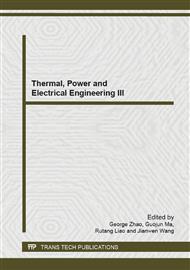[1]
Simulation Study on Dynamic Response of Doubly Fed Induction Generators During System Voltage Sag Caused by Power Grid Faults[J]. Power System Technology, 2010, 34(8): 170-175(in Chinese).
Google Scholar
[2]
Jia Junchuan, Liu Jin, Zhang Yigong. Dynamic Characteristics of Stator Flux of Doubly-fed Induction Generator During Grid Voltage Fault[J]. Proceedings of the CSEE, 2011, 31(3): 90-96(in Chinese).
DOI: 10.1109/cris.2010.5617514
Google Scholar
[3]
Analysis on Low Voltage Ride-Through Techniques for Wind Turbines Using Doubly-Fed Induction Generator[J]. Power System Technology, 2010, 33(9): 72-77(in Chinese).
DOI: 10.1109/appeec.2012.6307096
Google Scholar
[4]
Crowbar control strategy for doubly fed induction generator of wind farm during power grid voltage dips[J]. Power System Technology, 2008, 32(12): 84-89(in Chinese).
DOI: 10.1109/epe.2005.219521
Google Scholar
[5]
Yang Shuying, Zhang Xing, Zhang Chongwei, et al. Electro-magnetic Transition of Doubly Fed Wind Turbines Initiated by Voltage Dip [J]. Automation of Electric Power Systems, 2008, 32(19): 85-91(in Chinese).
Google Scholar
[6]
Li Qin, Zhang Xing, Yang Shuying, et al. Dynamic Behavior of DFIG Rotor During Low Voltage Ride-Through[J]. Proceedings of the CSU-EPSA, 22010, 22(5): 19-24(in Chinese).
Google Scholar
[7]
Guo Jiahu, Zhang Luhua, Cai Xu. Dynamic Response of Wind Power Generation Based on DFIG Under Grid Fault [J]. Acta Energiae Solaris Sinica, 2010, 31(8): 1023-1029(in Chinese).
DOI: 10.1109/ipemc.2009.5157782
Google Scholar
[8]
Lopez J, Sanchis P, Roboam X, et al. Dynamic behavior of the doubly fed induction generator during three-phase voltage dips[J]. IEEE Trans on Energy Conversion, 2007, 22(3): 709-717.
DOI: 10.1109/tec.2006.878241
Google Scholar
[9]
Li Hui, Zhao Meng, Ye Renjie, et al. Evaluation and analysis of transient current of a DFIG wind generation system under grid fault[J]. Electric Machines and Control, 2010, 14(8): 45-51(in Chinese).
Google Scholar
[10]
Zhang Xueguang, Xu Dianguo, Li Weiwei. Analysis of three-phase short circuit current of doubly fed induction generator[J]. Electric Machines and Control, 2008, 12(5): 493-497(in Chinese).
Google Scholar
[11]
Shi Yihui, Lu Zongxiang, Min Yong, et al. Practical Calculation Model of Three-phase Short-circuit Current for Doubly-fed Induction Generator [J]. Automation of Electric Power Systems, 2011, 35(8): 38-43(in Chinese).
Google Scholar
[12]
Hao Zhenghang, Yu Yixin, Zeng Yuan. Transient performance of DFIG power angle in wind farm and its control strategy [J]. Electric Power Automation Equipment , 2011, 31(2): 79-83 (in Chinese).
Google Scholar
[13]
Hao Zhenghang, Yu Yixin. The influence of doubly-fed induction generator on stability of power system [J]. Relay, 2011, 39(3): 7-11 (in Chinese).
Google Scholar
[14]
Hughes F. M, Anaya-Lara O, Jenkins N, et al. Control of DFIG-Based Wind Generation for Power Network Support [J]. IEEE Trans on Power Systems, 2005, 20(4): 1958-(1966).
DOI: 10.1109/tpwrs.2005.857275
Google Scholar
[15]
Tang Yunmiao. Motor Theory[M]. Beijing: Tsinghua University Press, 2002: 179-193.
Google Scholar


